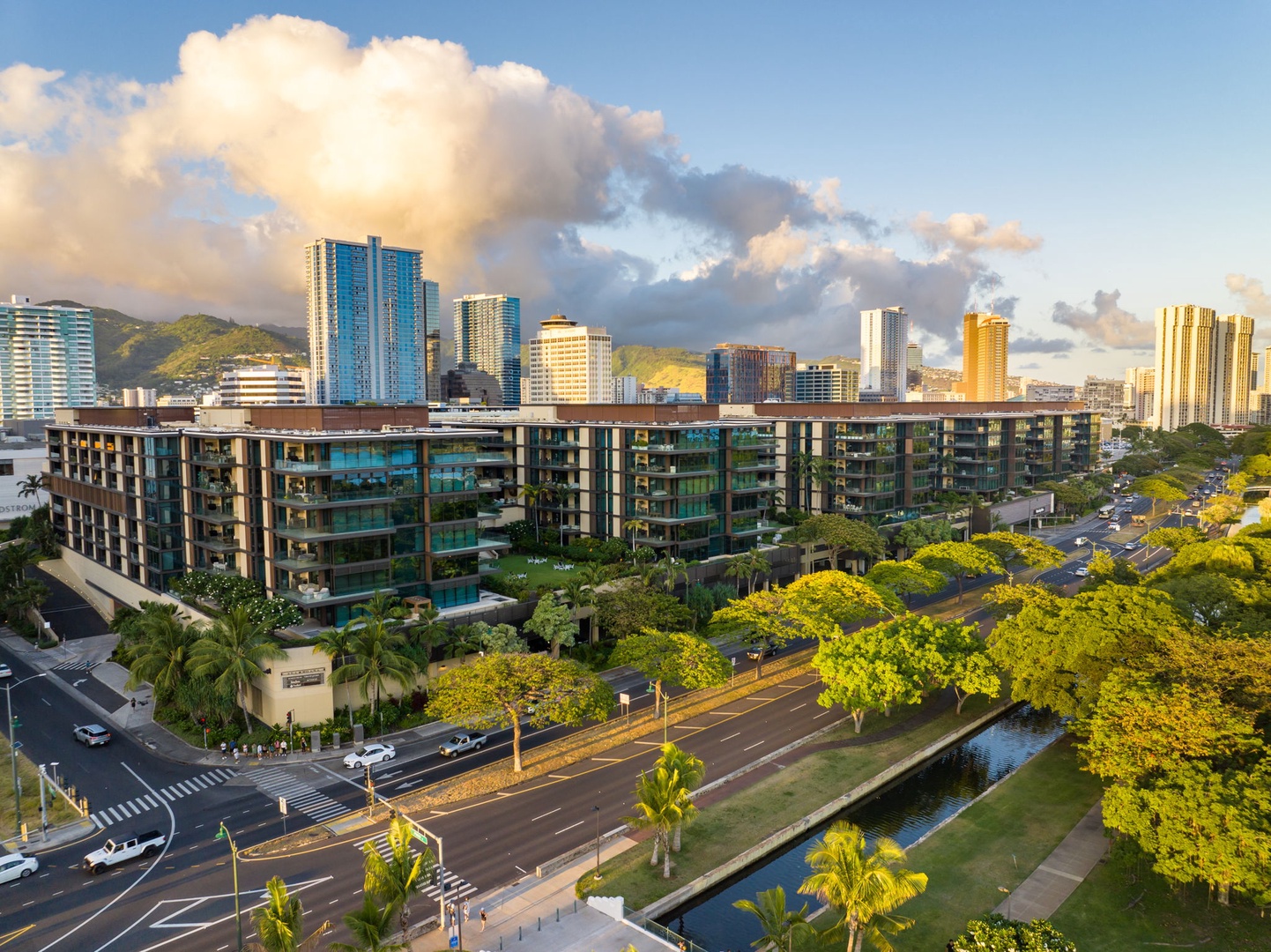Ala Moana
NEIGHBORHOOD
Ala Moana, meaning “path to the sea” in Hawaiian, is a coastal district in Honolulu, situated between the iconic neighborhoods of Waikīkī and Kaka‘ako. Once a landscape of wetlands, fishponds, and small farms used by Native Hawaiians, the area underwent dramatic change in the early 20th century as Honolulu began to modernize and expand.
Today, Ala Moana is one of Honolulu’s most sought-after and strategically located neighborhoods, offering a dynamic blend of urban sophistication and coastal living. Its real estate market has become a major focal point for luxury residential development, with demand fueled by both local buyers and international investors from Asia, North America, and beyond.
ORIGINE OF ALA MOANA PARK
The heart of the neighborhood—Ala Moana Beach Park—has its roots in the 1930s. The park was part of a visionary land reclamation project led by industrialist Walter F. Dillingham, who used coral fill dredged from the nearby harbors to create new land. Originally known as the “People’s Park,” it was developed as a public space to provide locals with access to the ocean, and was officially opened in 1934. Its man-made beach and calm, reef-protected waters made it ideal for swimming, paddling, and family gatherings. Over time, the park became a vital green space in Honolulu, reflecting a commitment to community, It offers shaded walking and riding paths, tennis courts, picnic areas, and a protected swimming lagoon popular with families and water enthusiasts. Adjacent to the park is Magic Island, a man-made peninsula originally intended as a resort site but later preserved as public land. Today, it is a favorite spot for jogging, sunset viewing, and community events, offering sweeping views of the Honolulu skyline and Diamond Head.
EARLY REAL ESTATE DEVELOPMENT
Following the park’s development, the surrounding area saw increasing interest from both private and public sectors. During the 1950s, with the growth of Honolulu as a metropolitan city, Ala Moana became a prime location for urban expansion. The construction of Ala Moana Center in 1959 was a landmark moment—not only did it become the largest shopping center in the U.S. at the time, but it also anchored a wave of real estate activity in the area.
This period saw the rise of mid-century residential buildings, catering to middle-class families and urban professionals. Over time, Ala Moana evolved into a dynamic mix of high-rise condominiums, luxury residences, office buildings, and retail destinations. The neighborhood attracted both local buyers and international investors, drawn by its central location, ocean views, and proximity to Waikīkī and downtown Honolulu.
LOCAL LIFESTYLE
The skyline around Ala Moana has transformed significantly over the past two decades, with the emergence of high-rise condominiums and luxury high-rise condominiums offering panoramic ocean views, resort-style amenities, and direct access to premier shopping and dining. Flagship residential properties such as Park Lane Ala Moana, have set new standards for upscale condominium living in Hawai‘i. These developments appeal to discerning buyers seeking exclusivity, convenience, and a cosmopolitan lifestyle steps away from Ala Moana Center and the beach park.

Park Lane Ala Moana Luxury Condominium
DEMOGRAPHIC DATA FOR ALA MOANA
Ala Moana’s demographic is a dynamic blend of young professionals, affluent investors, creative entrepreneurs, and long-time Hawai‘i residents drawn to the area’s modern urban lifestyle and proximity to the ocean. The neighborhood particularly appeals to Millennials and Gen Xers who value convenience, design-forward living spaces, and a vibrant, walkable community. Many residents are employed in nearby business districts or work remotely in tech, design, or healthcare industries, contributing to a progressive, globally minded culture. The influx of international buyers—especially from Japan, Korea, and Canada—has also added a cosmopolitan flair, particularly in luxury towers like Waiea and Anaha. Meanwhile, mixed-income housing options and reserved housing initiatives attract local families and first-time homeowners, ensuring a diverse and inclusive community. This balance of luxury and accessibility, coupled with cultural events, art installations, and culinary experiences, makes Ala Moana one of Honolulu’s most socially and economically diverse neighborhoods.
ALL DATA FROM UNITED STATES CENSUS BUREAU 2023 - DATA FOR KAKA'AKO & ALA MOANA AREAS, ZIP CODE 96814
TOTAL POPULATION
0
TOTAL HOUSING UNITS
0
TOTAL HOUSEHOLDS
0
MEDIAN HOUSEHOLD INCOME
$0
EMPLOYMENT RATE
0%
POPULATION BY AGE GROUP
OCCUPATION (Population 16 years and older)
CLASS OF WORKERS
EDUCATION ATTAINMENT (Population 25 years and older)
FROM A REAL ESTATE PERSPECTIVE
As of early 2025, the Ala Moana real estate market is experiencing a nuanced shift, offering both challenges and opportunities for buyers and sellers. The median home sale price stands at $860,000, reflecting a slight 0.9% decrease year-over-year. Notably, one-bedroom units saw an 8.8% decline to $625,000, while two-bedroom units appreciated by 4.8% to $975,000 . Inventory levels have risen across all categories, with a notable 9.8% increase in two-bedroom listings from January to February 2025. This uptick in supply has led to a more balanced market, where 84% of homes are selling below asking price and the average days on market have extended to 101 days, a 73% increase from the previous year . These trends indicate a shift towards a buyer-friendly environment, providing greater negotiation leverage and a wider selection of properties. For sellers, strategic pricing and enhanced property presentation are becoming increasingly crucial to attract discerning buyers in this evolving market landscape.
Work With Patrick
“Patrick’s international lifestyle and deep-rooted community connections have equipped him with a strong cultural awareness that enables him to build meaningful relationships with clients locally and from all over the world.”
